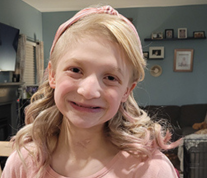A cholesteatoma is a benign growth of skin cells behind the eardrum. While a cholesteatoma is not cancerous, it can cause symptoms, such as pain, dizziness, numbness or weakness of facial muscles, and hearing loss if not found and surgically removed.
One of our National Foundation for Ectodermal Dysplasias (NFED) Board members raised the question about whether individuals affected by certain types of ectodermal dysplasia might be at increased risk for developing a cholesteatoma and the potential physical signs and symptoms listed above. Individuals with cleft palate are known to be at increased risk of developing a cholesteatoma.
The NFED funded a study to learn more. Below, research fellow Radhika Duggal shares their findings.
Risk & Recommendation
By Radhika Duggal, Medical Student at Cleveland Clinic Lerner College of Medicine and Case Western Reserve University
In a recent survey study conducted among NFED members with ectodermal dysplasia types that have been associated with an increased risk of a cleft palate [such as ectrodactyly, ectodermal dysplasia, and cleft lip/palate syndrome (EEC); ankyloblepharon-ectodermal defects-cleft lip/palate syndrome (AEC), and Goltz syndrome/focal dermal hypoplasia], we found that individuals with these types of ectodermal dysplasia have a significantly increased risk of having a cholesteatoma, even when compared to individuals in the general population who have a cleft palate without being affected by ectodermal dysplasia.
Given these findings, we recommend close monitoring with ear exams by primary care physicians and otolaryngologists to identify potential cholesteatomas early, and to avoid the potentially serious complications associated with cholesteatomas.
Study Publication
The study was published in the International Journal of Pediatric Otorhinolaryngology. The authors include Radhika Duggal, a medical student at the Cleveland Clinic Lerner College of Medicine and Case Western Reserve University; NFED Scientific Advisory Council Members Brandon Hopkins M.D. and Clayton Butcher, M.D.; NFED Director of Treatment and Research Advocacy, Becky Abbott, M.P.H.; and NFED Executive Director Mary Fete M.S.N., R.N., C.C.M.
You can read the full publication in the International Journal of Pediatric Otorhinolaryngology.
